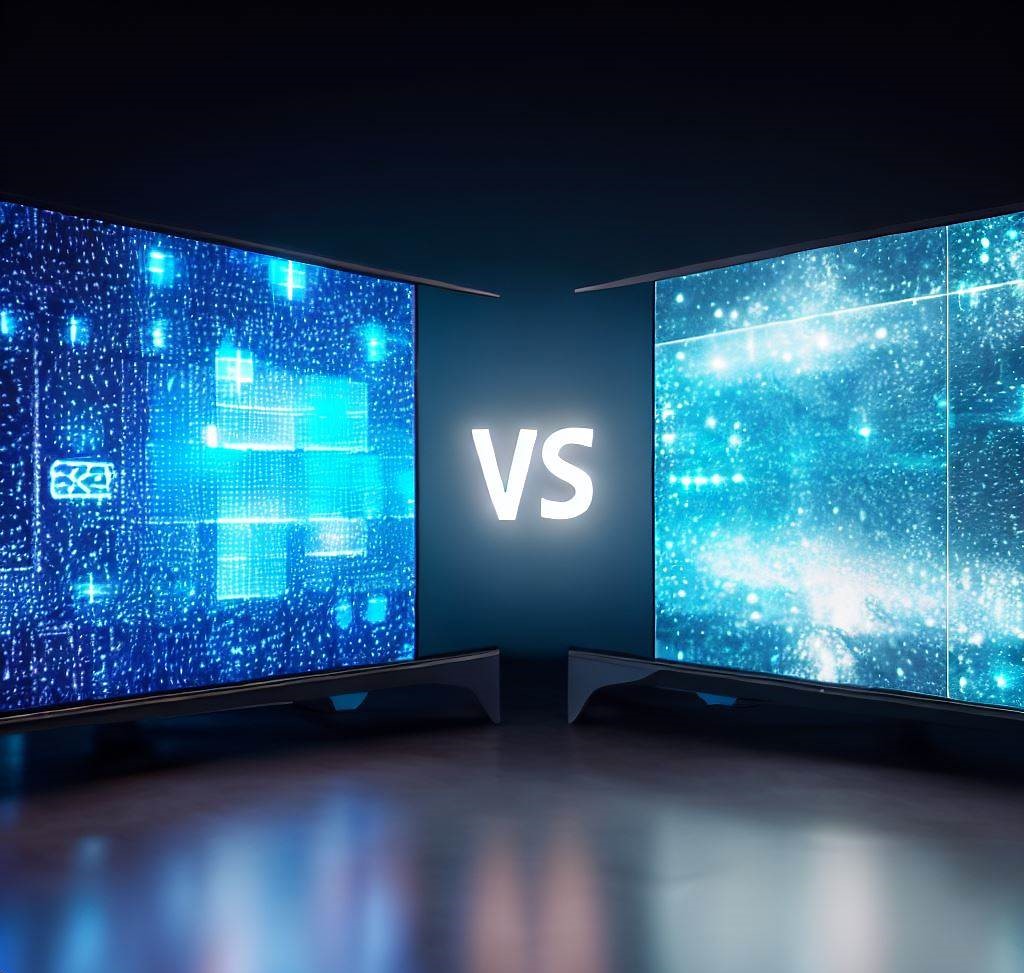Table of Contents
OLED and QLED are two of the most popular TV technologies on the market today. They offer different advantages and disadvantages, so it’s important to understand the differences between them before making a purchase.

What Is QLED?
QLED stands for “quantum dot light-emitting diode.” It is a type of LED TV that uses quantum dots to improve the color and brightness of the picture. Quantum dots are tiny semiconductor particles that emit different colors of light depending on their size. In a QLED TV, the quantum dots are sandwiched between a blue LED backlight and an LCD panel. The blue light from the LED backlight is absorbed by the quantum dots, which then emit red and green light. This results in a wider color gamut and more vibrant colors than a traditional LED TV.
QLED TVs also have higher brightness than traditional LED TVs. This is because the quantum dots can absorb more light from the LED backlight, which means that they can emit more light themselves. This makes QLED TVs a good choice for viewing in bright rooms.
However, QLED TVs do not have the same infinite contrast ratio as OLED TVs. This is because the quantum dots cannot turn off completely, so there is always some light coming from the backlight. This can result in a slightly grayish appearance in dark scenes.
Overall, QLED TVs are a good choice for people who want a TV with vibrant colors and high brightness. They are not as good as OLED TVs in terms of contrast ratio, but they are a more affordable option.
- Brightness: QLED TVs have higher brightness than OLED TVs, which can be an advantage in bright rooms.
- Color gamut: QLED TVs have a wide color gamut, meaning that they can display a wide range of colors. This results in more vibrant and realistic images.
- Price: QLED TVs are less expensive than OLED TVs.
- Not as good at displaying blacks: QLED TVs cannot produce true blacks like OLED TVs, because the backlight is always on. This can result in a slightly grayish appearance in dark scenes.
- Narrower viewing angles: QLED TVs do not have as wide viewing angles as OLED TVs, so the image quality can degrade when viewed from an angle.
Here are some of the advantages of QLED TVs:
- Wide color gamut: QLED TVs can display a wider range of colors than traditional LED TVs. This results in more vibrant and realistic images.
- High brightness: QLED TVs are brighter than traditional LED TVs, which can be an advantage in bright rooms.
- Long lifespan: QLED TVs have a long lifespan, which means that they will last for many years.
- Affordable: QLED TVs are more affordable than OLED TVs.
Here are some of the disadvantages of QLED TVs:
- Not as good at displaying blacks: QLED TVs cannot produce true blacks like OLED TVs, because the backlight is always on. This can result in a slightly grayish appearance in dark scenes.
- Not as wide viewing angles: QLED TVs do not have as wide viewing angles as OLED TVs, so the image quality can degrade when viewed from an angle.
- Burn-in risk: QLED TVs are not as susceptible to burn-in as OLED TVs, but it is still a possibility.
Ultimately, the best choice for you will depend on your individual needs and preferences. If you are looking for the best possible picture quality, then OLED is the way to go. However, if you are on a budget or you need a TV that can handle bright rooms well, then QLED is a good option.
What Is OLED?
OLED stands for organic light-emitting diode. It is a type of display technology that uses organic molecules to emit light. OLED displays are self-emissive, meaning that each pixel on the display can produce its own light.
- Contrast ratio: OLED TVs have an infinite contrast ratio, which means that they can produce true blacks. This is because each pixel on an OLED TV can be individually turned off, resulting in deep, inky blacks that are simply not possible with other TV technologies.
- Viewing angles: OLED TVs have wide viewing angles, meaning that the image quality does not degrade when viewed from an angle. This is because each pixel on an OLED TV emits its own light, so there is no need for a backlight, which can wash out the image when viewed from an angle.
- Response time: OLED TVs have very fast response times, meaning that they can display fast-moving images without blur. This makes them ideal for gaming and watching action movies.
- Brightness: OLED TVs have lower brightness than QLED TVs, but they are still bright enough for most viewing conditions.
- Color gamut: OLED TVs have a wide color gamut, meaning that they can display a wide range of colors. This results in more vibrant and realistic images.
- Burn-in risk: OLED TVs are susceptible to burn-in, which is when a static image is displayed for a long period of time and leaves a permanent mark on the screen. This is not a common problem, but it is something to be aware of if you plan on watching a lot of news channels or sports broadcasts with static logos.
Here are some of the advantages of OLED displays:
- Infinite contrast ratio: OLED displays can produce true blacks, because the pixels can turn off completely. This results in deep, inky blacks that are simply not possible with other display technologies.
- Wide viewing angles: OLED displays maintain their image quality from virtually any viewing angle. This is because each pixel on an OLED display emits its own light, so there is no need for a backlight, which can wash out the image when viewed from an angle.
- Fast response times: OLED displays have very fast response times, which makes them ideal for gaming and watching fast-paced action movies.
- Thin and light: OLED displays are very thin and light, making them ideal for portable devices such as smartphones and tablets.
Here are some of the disadvantages of OLED displays:
- Burn-in risk: OLED displays are susceptible to burn-in, which is when a static image is displayed for a long period of time and leaves a permanent mark on the screen. This is not a common problem, but it is something to be aware of if you plan on watching a lot of news channels or sports broadcasts with static logos.
- Price: OLED displays are more expensive than other display technologies, such as LED.
Ultimately, the best choice for you will depend on your individual needs and preferences. If you are looking for the best possible picture quality, then OLED is the way to go. However, if you are on a budget or you need a TV that can handle bright rooms well, then another display technology may be a better option.
Comparing OLED and QLED TVs
| Feature | OLED | QLED |
|---|---|---|
| Technology | Organic light-emitting diode (OLED) | Quantum dot LED (QLED) |
| Contrast ratio | Infinite | High |
| Viewing angles | Wide | Narrower than OLED |
| Response time | Very fast | Fast |
| Brightness | Lower | Higher |
| Color gamut | Wide | Wide |
| Burn-in risk | Yes | No |
| Price | More expensive | Less expensive |
Also Read BEST 4K TV under 40000 in India
Which is better? – OLED VS QLED
OLED and QLED are both excellent TV technologies, and the best choice for you will depend on your individual needs and preferences. If you are looking for the best possible picture quality, then OLED is the way to go. However, if you are on a budget or you need a TV that can handle bright rooms well, then QLED is a good option.
Ultimately, the best way to decide which TV technology is right for you is to see them side-by-side and compare them for yourself.
Here are some additional factors to consider when choosing between OLED and QLED TVs:
- Room lighting: If you watch TV in a dark room, then OLED is the better choice, as it can produce true blacks. If you watch TV in a bright room, then QLED may be a better choice, as it can get brighter.
- Content: If you watch a lot of HDR content, then OLED is the better choice, as it can display a wider range of colors. If you watch a lot of sports or news, then QLED may be a better choice, as it can handle bright images well.
- Budget: OLED TVs are more expensive than QLED TVs. If you are on a budget, then QLED is a better option.


